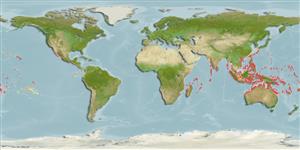Environment: milieu / climate zone / depth range / distribution range
Ecología
marino asociado a arrecife; no migratorio; rango de profundidad 1 - 25 m (Ref. 9710). Tropical; 32°N - 24°S
Indo-Pacific: East Africa south to Aliwal Shoal, South Africa (Ref. 4421) and east to Fiji, north to southern Japan, south to the southern Great Barrier Reef and New Caledonia. Recently recorded from Tonga (Ref. 53797). Replaced by Paraluteres arquat in the Red Sea.
Tamaño / Peso / Age
Maturity: Lm ? range ? - ? cm
Max length : 11.0 cm TL macho / no sexado; (Ref. 4421)
Short description
Claves de identificación | Morfología | Morfometría
Espinas dorsales (total) : 2; Radios blandos dorsales (total) : 25 - 28; Espinas anales: 0; Radios blandos anales: 22 - 25. Ranges from pale greenish to dirty white in color; blackish-brown saddles above; normally with a round dark blotch above origin of anal fin; soft dorsal and anal fins hyaline, tips dusky; caudal fin yellowish (Ref. 4421).
Inhabit clear lagoon and seaward reefs to at least 25 meters (Ref. 5503). Solitary or in small groups (Ref. 9710). Adults usually in pairs, but sometimes seen in small aggregations (Ref. 48637). Mimic the poisonous puffer, Canthigaster valentini which it greatly resembles. Feed on eggs, gastropods and grazes the substrate (Ref. 5503, 48637).
Life cycle and mating behavior
Madurez | Reproducción | Puesta | Huevos | Fecundidad | Larva
Myers, R.F., 1991. Micronesian reef fishes. Second Ed. Coral Graphics, Barrigada, Guam. 298 p. (Ref. 1602)
IUCN Red List Status (Ref. 130435: Version 2024-1)
Human uses
Herramientas
Special reports
Download XML
Fuentes de Internet
Estimates based on models
Preferred temperature (Ref.
123201): 25.2 - 29.3, mean 28.4 °C (based on 2764 cells).
Phylogenetic diversity index (Ref.
82804): PD
50 = 0.7500 [Uniqueness, from 0.5 = low to 2.0 = high].
Bayesian length-weight: a=0.01995 (0.00956 - 0.04164), b=2.93 (2.76 - 3.10), in cm total length, based on LWR estimates for this (Sub)family-body shape (Ref.
93245).
Nivel trófico (Ref.
69278): 2.7 ±0.44 se; based on food items.
Resiliencia (Ref.
120179): Alto, población duplicada en un tiempo mínimo inferior a 15 meses (Preliminary K or Fecundity.).
Fishing Vulnerability (Ref.
59153): Low vulnerability (10 of 100).
Nutrients (Ref.
124155): Calcium = 91.9 [39.7, 238.6] mg/100g; Iron = 0.901 [0.405, 2.114] mg/100g; Protein = 17.9 [15.6, 20.1] %; Omega3 = 0.11 [0.05, 0.23] g/100g; Selenium = 27.5 [12.9, 64.2] μg/100g; VitaminA = 72 [20, 274] μg/100g; Zinc = 1.79 [1.13, 2.88] mg/100g (wet weight);
